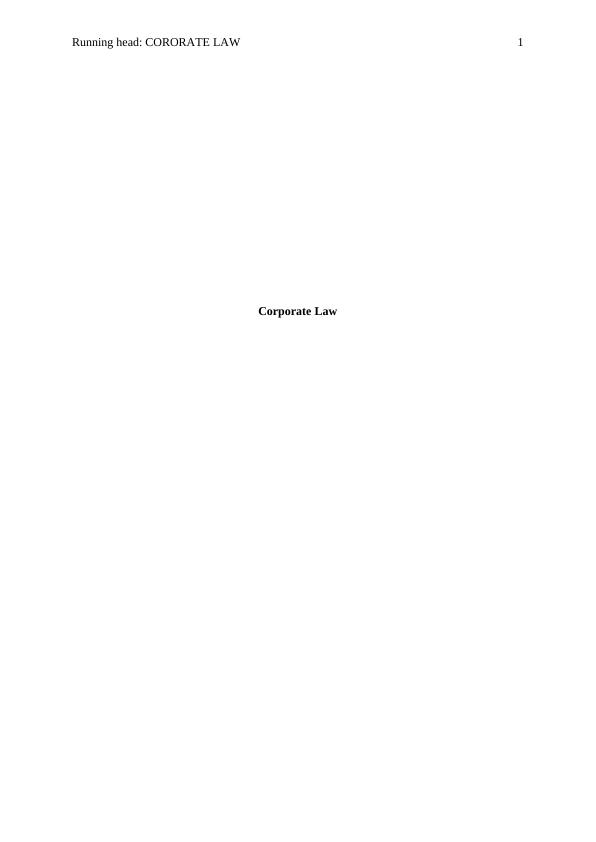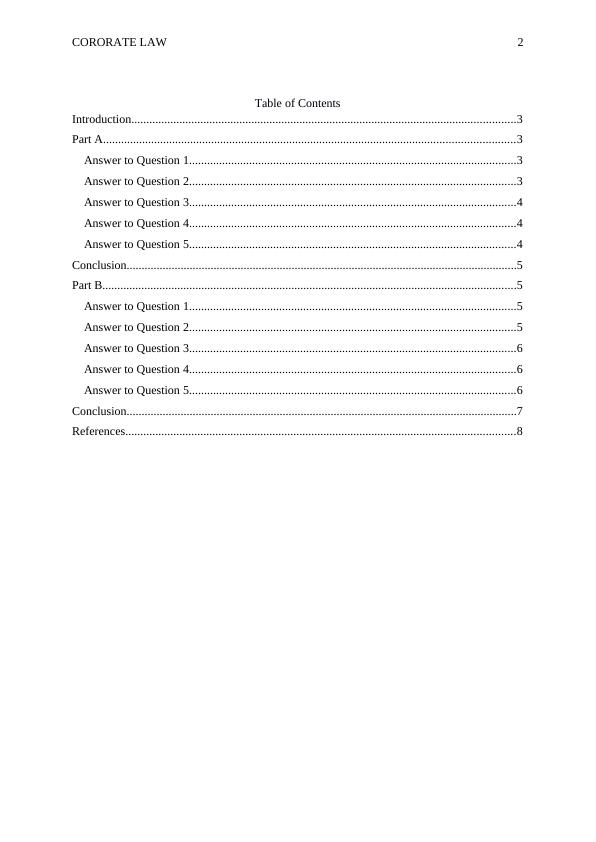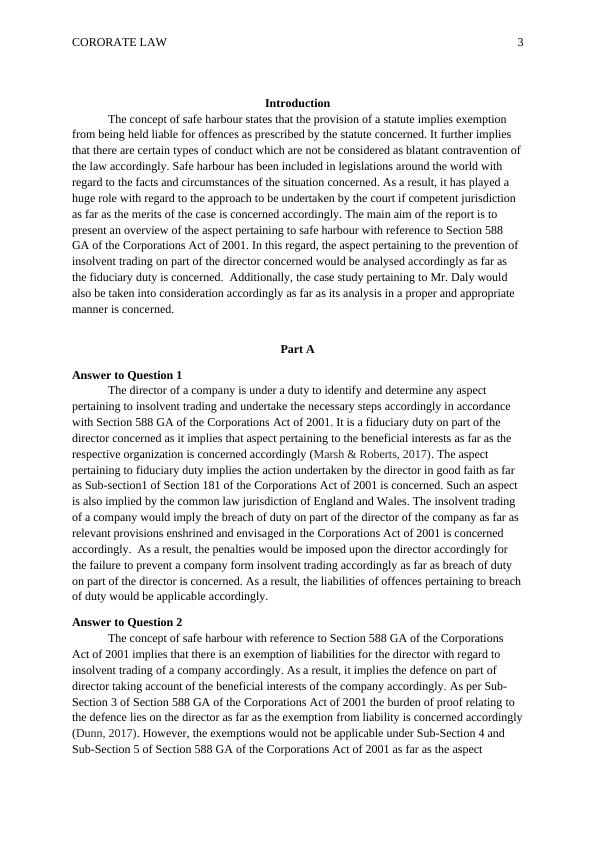Corporate Law
Added on 2023-03-23
8 Pages2991 Words29 Views
Running head: CORORATE LAW 1
Corporate Law
Corporate Law

CORORATE LAW 2
Table of Contents
Introduction................................................................................................................................3
Part A.........................................................................................................................................3
Answer to Question 1.............................................................................................................3
Answer to Question 2.............................................................................................................3
Answer to Question 3.............................................................................................................4
Answer to Question 4.............................................................................................................4
Answer to Question 5.............................................................................................................4
Conclusion..................................................................................................................................5
Part B..........................................................................................................................................5
Answer to Question 1.............................................................................................................5
Answer to Question 2.............................................................................................................5
Answer to Question 3.............................................................................................................6
Answer to Question 4.............................................................................................................6
Answer to Question 5.............................................................................................................6
Conclusion..................................................................................................................................7
References..................................................................................................................................8
Table of Contents
Introduction................................................................................................................................3
Part A.........................................................................................................................................3
Answer to Question 1.............................................................................................................3
Answer to Question 2.............................................................................................................3
Answer to Question 3.............................................................................................................4
Answer to Question 4.............................................................................................................4
Answer to Question 5.............................................................................................................4
Conclusion..................................................................................................................................5
Part B..........................................................................................................................................5
Answer to Question 1.............................................................................................................5
Answer to Question 2.............................................................................................................5
Answer to Question 3.............................................................................................................6
Answer to Question 4.............................................................................................................6
Answer to Question 5.............................................................................................................6
Conclusion..................................................................................................................................7
References..................................................................................................................................8

CORORATE LAW 3
Introduction
The concept of safe harbour states that the provision of a statute implies exemption
from being held liable for offences as prescribed by the statute concerned. It further implies
that there are certain types of conduct which are not be considered as blatant contravention of
the law accordingly. Safe harbour has been included in legislations around the world with
regard to the facts and circumstances of the situation concerned. As a result, it has played a
huge role with regard to the approach to be undertaken by the court if competent jurisdiction
as far as the merits of the case is concerned accordingly. The main aim of the report is to
present an overview of the aspect pertaining to safe harbour with reference to Section 588
GA of the Corporations Act of 2001. In this regard, the aspect pertaining to the prevention of
insolvent trading on part of the director concerned would be analysed accordingly as far as
the fiduciary duty is concerned. Additionally, the case study pertaining to Mr. Daly would
also be taken into consideration accordingly as far as its analysis in a proper and appropriate
manner is concerned.
Part A
Answer to Question 1
The director of a company is under a duty to identify and determine any aspect
pertaining to insolvent trading and undertake the necessary steps accordingly in accordance
with Section 588 GA of the Corporations Act of 2001. It is a fiduciary duty on part of the
director concerned as it implies that aspect pertaining to the beneficial interests as far as the
respective organization is concerned accordingly (Marsh & Roberts, 2017). The aspect
pertaining to fiduciary duty implies the action undertaken by the director in good faith as far
as Sub-section1 of Section 181 of the Corporations Act of 2001 is concerned. Such an aspect
is also implied by the common law jurisdiction of England and Wales. The insolvent trading
of a company would imply the breach of duty on part of the director of the company as far as
relevant provisions enshrined and envisaged in the Corporations Act of 2001 is concerned
accordingly. As a result, the penalties would be imposed upon the director accordingly for
the failure to prevent a company form insolvent trading accordingly as far as breach of duty
on part of the director is concerned. As a result, the liabilities of offences pertaining to breach
of duty would be applicable accordingly.
Answer to Question 2
The concept of safe harbour with reference to Section 588 GA of the Corporations
Act of 2001 implies that there is an exemption of liabilities for the director with regard to
insolvent trading of a company accordingly. As a result, it implies the defence on part of
director taking account of the beneficial interests of the company accordingly. As per Sub-
Section 3 of Section 588 GA of the Corporations Act of 2001 the burden of proof relating to
the defence lies on the director as far as the exemption from liability is concerned accordingly
(Dunn, 2017). However, the exemptions would not be applicable under Sub-Section 4 and
Sub-Section 5 of Section 588 GA of the Corporations Act of 2001 as far as the aspect
Introduction
The concept of safe harbour states that the provision of a statute implies exemption
from being held liable for offences as prescribed by the statute concerned. It further implies
that there are certain types of conduct which are not be considered as blatant contravention of
the law accordingly. Safe harbour has been included in legislations around the world with
regard to the facts and circumstances of the situation concerned. As a result, it has played a
huge role with regard to the approach to be undertaken by the court if competent jurisdiction
as far as the merits of the case is concerned accordingly. The main aim of the report is to
present an overview of the aspect pertaining to safe harbour with reference to Section 588
GA of the Corporations Act of 2001. In this regard, the aspect pertaining to the prevention of
insolvent trading on part of the director concerned would be analysed accordingly as far as
the fiduciary duty is concerned. Additionally, the case study pertaining to Mr. Daly would
also be taken into consideration accordingly as far as its analysis in a proper and appropriate
manner is concerned.
Part A
Answer to Question 1
The director of a company is under a duty to identify and determine any aspect
pertaining to insolvent trading and undertake the necessary steps accordingly in accordance
with Section 588 GA of the Corporations Act of 2001. It is a fiduciary duty on part of the
director concerned as it implies that aspect pertaining to the beneficial interests as far as the
respective organization is concerned accordingly (Marsh & Roberts, 2017). The aspect
pertaining to fiduciary duty implies the action undertaken by the director in good faith as far
as Sub-section1 of Section 181 of the Corporations Act of 2001 is concerned. Such an aspect
is also implied by the common law jurisdiction of England and Wales. The insolvent trading
of a company would imply the breach of duty on part of the director of the company as far as
relevant provisions enshrined and envisaged in the Corporations Act of 2001 is concerned
accordingly. As a result, the penalties would be imposed upon the director accordingly for
the failure to prevent a company form insolvent trading accordingly as far as breach of duty
on part of the director is concerned. As a result, the liabilities of offences pertaining to breach
of duty would be applicable accordingly.
Answer to Question 2
The concept of safe harbour with reference to Section 588 GA of the Corporations
Act of 2001 implies that there is an exemption of liabilities for the director with regard to
insolvent trading of a company accordingly. As a result, it implies the defence on part of
director taking account of the beneficial interests of the company accordingly. As per Sub-
Section 3 of Section 588 GA of the Corporations Act of 2001 the burden of proof relating to
the defence lies on the director as far as the exemption from liability is concerned accordingly
(Dunn, 2017). However, the exemptions would not be applicable under Sub-Section 4 and
Sub-Section 5 of Section 588 GA of the Corporations Act of 2001 as far as the aspect

End of preview
Want to access all the pages? Upload your documents or become a member.
Related Documents
Safe Harbour in Corporate Law: Analysis of Section 588 GA of the Corporations Act of 2001lg...
|8
|3088
|408
Breach of Duty as Director and Safe Harbour under Corporations Act of 2001lg...
|9
|3098
|256
Business Lawlg...
|12
|2710
|219
Understanding Business Law and Director's Dutieslg...
|11
|3023
|70
Insolvent Trading: Duties, Safe Harbour Defence, and Liability of Directorslg...
|13
|3403
|79
Corporate Law: Duties of Directors and Insolvent Tradinglg...
|11
|2701
|475
